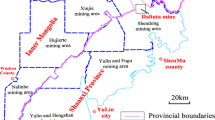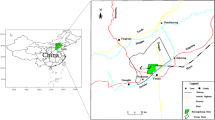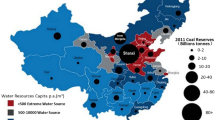Abstract
Barrier pillars are an effective and fundamental measure to prevent water inrush when mining shallow coal seams under an unconsolidated, confined aquifer. Based on the complex geological and hydrogeological conditions in the southern area of the Qidong coal mine, the no. 61 coal seam there was selected for a research demonstration. A fluid–solid coupled numerical simulation was carried out using the universal distinct element code. The hydraulic pressures and seepage rates in overlying strata were analyzed for two mining cases, near the aquifer and near the fault. The results showed that the degree of interconnection between the bed-separated and vertical fractures, and increases in hydraulic pressures and seepage rates in overlying strata were key factors in predicting potential water inrush when mining shallow coal seams under an unconsolidated, confined aquifer. Combining the numerical simulation results with China’s coal mining requirements, the no. 61 coal seam can be mined up to 90 m beneath the unconsolidated, confined aquifer, which limits mining to an altitude of −509.36 m. The width of the barrier pillar should be 30.7 m near the fault.
Zusammenfassung
Bergfesten als Barrieren sind eine effiziente und grundsätzliche Maßnahme, um Wassereinbrüchen beim Abbau von oberflächennahen Kohleflözen unter einem unverfestigten, gespannten Aquifer vorzukehren. Auf der Basis komplexer geologischer und hydrogeologischer Verhältnisse im südlichen Teil der Qidong Kohlenmine wurde das 61. Kohlenflöz für eine Forschungsdemonstration ausgewählt. Eine Fluid-Feststoff gekoppelte numerische Simulation wurde unter Nutzung des Universal Distinct Element Code (UDEC) ausgeführt. Hydraulische Drücke und Sickerraten in den überlagernden Schichten wurden für zwei Abbauvarianten untersucht, nahe am Aquifer und nahe an der Störung. Die Ergebnisse zeigten, daß der Verbindungsgrad zwischen Trennflächen parallel zur Schichtung und vertikalen Trennflächen, sowie der Anstieg hydraulischer Drücke und der Sickerraten in den Hangendschichten Schlüsselfaktoren für die Vorhersage potentieller Wassereinbrüche sind, wenn oberflächennahe Kohleflöze unter einem unverfestigten, gespannten Aquifer abgebaut werden. Die Zusammenführung der Resultate der numerische Simulation mit Chinas Anforderungen an den Kohlenbergbau zeigt, daß das 61. Kohlenflöz bis 90 m unter den unverfestigten, gespannten Aquifer abgebaut werden kann, das heißt bis zu einer Höhe von −509,36 m. Nahe an der Störung sollte die Bergfeste als Barriere eine Breite von 30.7 m aufweisen.
Resumen
Los pilares barrera son una medida fundamental y efectiva para prevenir las irrupciones de agua para la minería de vetas de carbón de poca profundidad bajo un acuífero confinado y no consolidado. Basados en las complejas condiciones geológicas e hidrogeológicas en el área sur de la mina de carbón Qidong, la veta de carbón no. 61 fue seleccionada para una demostración. Se realizó una simulación numérica de acoplamiento sólido-fluído usando el código universal de elementos distintos (UDEC). Las presiones hidráulicas y los índices de filtración en estratos superpuestos fueron analizadas para dos casos de minería cerca del acuífero y cerca de la falla. Los resultados mostraron que el grado de interconexión entre el lecho separado y las fracturas verticales, y el incremento de las presiones hidráulicas y los índices de filtración en estratos superpuestos, fueron factores clave en la predicción de la potencial irrupción de agua en la minería de vetas de carbón debajo de un acuífero confinado y no consolidado. Combinando los resultados de la simulación numérica con los requerimientos de la minería de carbón en China, la veta de carbón no. 61 debería ser explotada hasta 90 m debajo del acuífero confinado, no consolidado, que limita la minería a una altitud de −509,36 m. El ancho del pilar barrera debería ser 30,7 m cerca de la falla.
摘要
防水煤岩柱的留设能够有效预防松散承压含水层下浅部煤层开采时顶板突水事故的发生。根据祁东煤矿南部采区复杂地质及水文地质条件,选取61煤层为研究对象,利用通用离散元软件UDEC进行流固耦合数值模拟,分析了近松散承压含水层与近断层两种开采方案中的覆岩水压与渗流速率。结果表明:离层裂隙与垂向裂隙彼此的连通程度和覆岩水压与渗流速率的增大是识别松散承压含水层下开采潜在突水的关键因素。结合数值模拟结果与中国煤炭开采规程,确定了61煤层能够被开采至松散承压含水层以下90 m(上限标高为−509.36 m);断层防水煤岩柱宽度为30.7 m。







Similar content being viewed by others
References
Chen LW, Gui HR, Li YF (2007) UDEC simulation of the water-pouring probability in exploiting waterproof coal pillars under the conditions of thick loose bed and ultrathin overlying strata. Hydrogeol Eng Geol 34(1):53–56 (in Chinese)
Chen LW, Zhang SL, Gui HR (2014) Prevention of water and quicksand inrush during extracting contiguous coal seams under the lowermost aquifer in the unconsolidated Cenozoic alluvium—a case study. Arab J Geosci 7(6):2139–2149
Gui HR (1997) Stress analysis and calculation method in waterproof coal (rock) pillar reasonable design. China Coal Industry Publ House, Beijing (in Chinese)
Guo PK, Cheng YP, Jin K, Liu YP (2014) The impact of faults on the occurrence of coal bed methane in Renlou coal mine, Huaibei coalfield, China. J Nat Gas Sci Eng 17:151–158
Itasca (2004) UDEC version 4.0 user’s manual. Itasca Consulting Group Inc, Minneapolis
Jaiswal A, Shrivastva BK (2009) Numerical simulation of coal pillar strength. Int J Rock Mech Min 46(4):779–788
Koehler JR, Tadolini SC (1995) Practical design methods for barrier pillars. US Bureau of Mines, US Dept of the Interior, Washington, DC
LaMoreaux JW, Wu Q, Zhou WF (2014) New development in theory and practice in mine water control in China. Carbonate Evaporite 29(2):141–145
Liu CY, Liu YJ, Huang BX, Li YM, Li XM (2010) Instability characteristic and reasonable design of water-preventive coal-rock pillars in mining steep coal seam. J Min Safe Eng 27(3):330–334 (in Chinese)
Meng ZP, Gao YF, Lu AH, Wang R, Qiao X, Huang CY (2013) Water inrush risk evaluation of coal mining under Quaternary alluvial water and reasonable design method of waterproof coal pillar. J Min Safe Eng 30(1):23–29 (in Chinese)
Miao XX, Cui XM, Wang JA, Xu JL (2011) The height of fractured water-conducting zone in undermined rock strata. Eng Geol 120:32–39
Rangasamy T, Leach AR, Van Vuuren JJ, Cook AP, Brummer R (2001) Current practice and guidelines for the safe design of water barrier pillars. Durban, Itasca Africa (Pty) Ltd, SIMRAC
State Administration of Work Safety (SAWS), State Administration of Coal Mine Safety (SACMC) (2009) Chinese regulations for prevention and control of coal mine water. Publ House for Coal Industry, Beijing (in Chinese)
Sui WH, Liu JY, Yang SG, Chen ZS, Hu YS (2011) Hydrogeological analysis and salvage of a deep coalmine after a groundwater inrush. Envrion Earh Sci 62:735–749
Tan JQ, Ju YW, Yuan WM, Hou QL, Pan JN, Fan JJ (2011) Thermochronological and structural evolution of the Huaibei coalfield in eastern China: Constrains from zircon fission-track data. Radiat Meas 46(2):183–189
Wang JA, Wei XH, Chen SJ (2012a) Fissure and seepage characteristics in the floor strata when mining above a confined aquifer. J China Univ Min Technol 41(4):536–542 (in Chinese)
Wang XZ, Xu JL, Zhu WB, Li YC (2012b) Roof pre-blasting to prevent support crushing and water inrush accidents. Int J Min Sci Technol 22(3):379–384
Wang HF, Wang L, Cheng YP, Zhou HX (2013) Characteristics and dominant controlling factors of gas outburst in Huaibei coalfeld and its countermeasures. Int J Min Sci Technol 23:591–596
Wu Q (2009) Paraphrases of coalmine water control stipulations. China University of Mining and Technology Press, Xuzhou (in Chinese)
Wu SY, Hu BL, Yao DX, Zhang DS (2010) Analysis on geological structures influencing gas occurrence at Qidong coalmine. J Coal Sci Eng 16(3):292–295
Wu Q, Fan ZL, Zhang ZW, Zhou WF (2014) Evaluation and zoning of groundwater hazards in Pingshuo No. 1 underground coal mine, Shanxi Province, China. Hydrogeol J 22(7):1693–1705
Wu Q, Liu YZ, Zhou WF, Li BY, Zhao B, Liu SQ, Sun WJ, Zeng YF (2015) Evaluation of water inrush vulnerability from aquifers overlying coal seams in the Menkeqing coal mine, China. Mine Water Environ 34(3):258–269
Xu YC (2005) Design methods of the effective water-resisting thickness for the protective seam of the water barrier in fully-caving mechanized coalmining. J China Coal Soc 30(3):305–308
Xu JL, Zhu WB, Wang XZ (2011) Study on water-inrush mechanism and prevention during coal mining under unconsolidated confined aquifer. J Min Saf Eng 28(3):333–339
Yao BH, Bai HB, Zhang BY (2012) Numerical simulation on the risk of roof water in Wuyang coal mine. Int J Min Sci Technol 22(2):273–277
Zhang JC, Peng SP (2005) Water inrush and environmental impact of shallow seam mining. Environ Geol 48(8):1068–1076
Zhang X, Sanderson DJ (1996) Numerical modelling of the effects of fault slip on fluid flow around extensional faults. J Struct Geol 18(1):109–119
Zhang YX, Tu SH, Bai QS, Li JJ (2012) Overburden fissure evolution laws and water-controlling technologies in mining very thick coal seam under water-rich roof. Int J Min Sci Technol 23:693–700
Zhang JX, Jiang HQ, Deng XJ, Ju F (2014) Prediction of the height of the water-conducting zone above the mined panel in solid backfill mining. Mine Water Environ 33(4):317–326
Zhu WC, Wei CH (2011) Numerical simulation on mining-induced water inrushes related to geologic structures using a damage-based hydromechanical model. Environ Earth Sci 62(1):43–54
Acknowledgments
This work was financially supported by the National Natural Science Foundation of China (Grants 41372244, 41172216, and 41373095) and the Anhui Natural Science Foundation of China (1308085ME61). The authors sincerely thank the reviewers for their thorough reviews and useful suggestions.
Author information
Authors and Affiliations
Corresponding author
Electronic supplementary material
Below is the link to the electronic supplementary material.
Rights and permissions
About this article
Cite this article
Chen, L., Feng, X., Xie, W. et al. Using a Fluid–Solid Coupled Numerical Simulation to Determine a Suitable Size for Barrier Pillars When Mining Shallow Coal Seams Beneath an Unconsolidated, Confined Aquifer. Mine Water Environ 36, 67–77 (2017). https://doi.org/10.1007/s10230-016-0404-6
Received:
Accepted:
Published:
Issue Date:
DOI: https://doi.org/10.1007/s10230-016-0404-6




